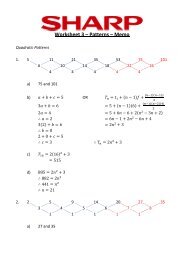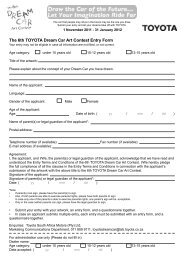curriculum and assessment policy statement (caps) - Department of ...
curriculum and assessment policy statement (caps) - Department of ...
curriculum and assessment policy statement (caps) - Department of ...
- No tags were found...
Create successful ePaper yourself
Turn your PDF publications into a flip-book with our unique Google optimized e-Paper software.
Content Area Content Clarification / Notes / Activities/ExamplesRecommended ResourcesApproximateDurationSuggested FormalAssessmentAdditionSubtractionKinaestheticExamples13. Teacher calls 3 learners to the front. Learners count them. Teacher calls another2 <strong>and</strong> asks: How many learners altogether?”3 <strong>and</strong> 2 → 5. (The teacher says: 3 <strong>and</strong> 2 makes 5)Teacher packs out 2 chairs. Add 2 more. How many chairs are there now? 2<strong>and</strong> 2 → 4.14. Teacher holds up one h<strong>and</strong>. And says: “Count my fingers. If I hide my thumb,how many fingers can you see? 5 take away 1 → 4.15. Let the learners count the fingers on one <strong>of</strong> their h<strong>and</strong>s. Hide your thumb; howmany fingers do you see? 5 take away 1 → 4.Concrete using 3-D objectsLet learners pack out 6 counters <strong>and</strong> do the following:4. The teacher gives each learner 6 counters. The teacher gives instructions <strong>and</strong>learners respond e.g., pack out 2 counters, add another 3. How manyaltogether. 2 <strong>and</strong> 3 → 5.5. Count 4 counters. Count 2 on from four. How many do you have now?4 <strong>and</strong> 2 → 6.6. Count all the beads you have. If you cover two beads with your h<strong>and</strong>, how manybeads do you see?6 take away 2 → 4.Objects <strong>and</strong> /or countersSemi-concrete using 2-D shapesMake number puzzles <strong>and</strong> allow the learners to explore with the puzzles.6 3 9 7 2 9Number puzzlesSpace <strong>and</strong> ShapeDevelop theconcepts <strong>of</strong> “biggest<strong>and</strong> smallest”• Reinforce the concept <strong>of</strong> “biggest/smallest”Kinaesthetic1 day By the end <strong>of</strong> week 33assess <strong>and</strong> record whetherlearners can:The teacher draws a small circle in the s<strong>and</strong>, on the ground/floor.‣ The learners walk on the outline <strong>of</strong> the small circleThe teacher draws a bigger circle on the outside <strong>of</strong> the circle‣ The learners walk on the outline <strong>of</strong> the bigger circle‣ The teacher asks:o Which circle is the smallest?”o “Which circle is biggest ”o “Walk on the small circle”o Walk on the big circleIdentify <strong>and</strong> underst<strong>and</strong> themeaning <strong>of</strong> the numbers 1 to8.Ability to link the samenumber <strong>of</strong> objects to thenumber <strong>of</strong> pictures <strong>and</strong>dots.The teacher draws an even bigger circle on the outside <strong>of</strong> the circle.‣ The learners walk on the outline <strong>of</strong> the biggest circle as well‣ The teacher asks questions such as:o Which <strong>of</strong> the circles is the biggest?” Big <strong>and</strong> small circles drawn in theUse <strong>and</strong> apply the number1 to 8 in familiar context.92 | P age
















